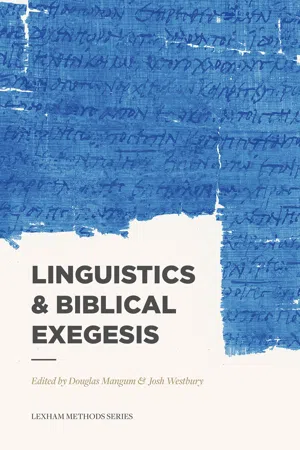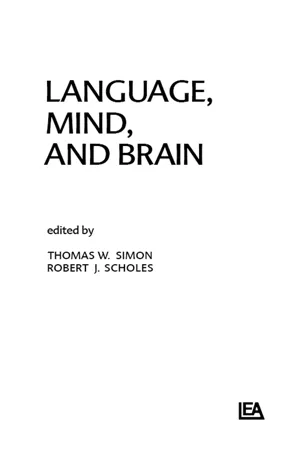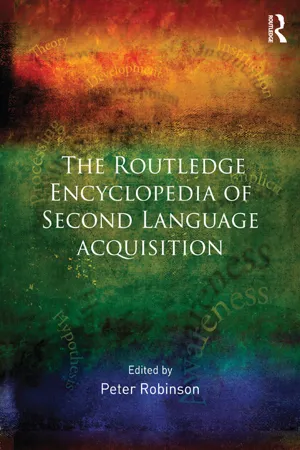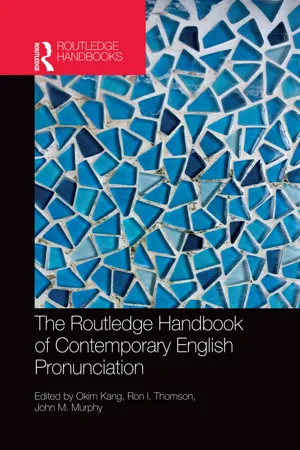Languages & Linguistics
Marked and Unmarked Terms
Marked and unmarked terms are linguistic concepts that refer to the degree of specificity or emphasis that a word or phrase carries in a given context. Marked terms are those that carry a more specific or emphasized meaning, while unmarked terms are more general or neutral. These concepts are important in understanding how language reflects and reinforces social and cultural norms.
Written by Perlego with AI-assistance
Related key terms
Related key terms
1 of 4
Related key terms
1 of 3
6 Key excerpts on "Marked and Unmarked Terms"
- eBook - ePub
- Douglas Mangum, Josh Westbury(Authors)
- 2017(Publication Date)
- Lexham Press(Publisher)
13 Conversely, if a scholar were to make a suggestion at the grammatical, syntactic, or discourse level of Biblical Greek, and that suggestion were unattested in all other languages similar to Biblical Greek, there would be good reason to rethink that suggestion. In short, linguistic typology and language universals give us stronger probability in making claims about how Biblical Hebrew and Greek work, and they prevent idiosyncratic suggestions from receiving undue influence.4.2 MarkednessThe notion of markedness has received a significant amount of attention in linguistic literature, resulting in an array of complex and sometimes disconnected definitions.14 In its most general sense, however, markedness may be defined as “an analytic principle in linguistics whereby pairs of linguistic features, seen as oppositions, are given different values of positive (marked) and neutral or negative (unmarked).”15 Put differently, the terms “marked” and “unmarked” are used to refer to the status or existence of particular linguistic features. Markedness relates to how much detail is communicated by a linguistic feature. For example, the English pronoun “they” indicates a plural group but gives no information about whether the group includes just men, just women, or a mix of both. The pronoun is marked for person (third) and number (plural) but unmarked for gender. By contrast, the Spanish pronoun “ellas” refers to a group of women and is marked for person (third), number (plural), and gender (feminine). The importance of this concept in linguistics is inestimable. Though it has its roots in phonology , markedness has been applied to almost every subdomain of linguistics. A brief explanation of the history of the concept will help make sense of present usage and why it is valuable in the study of biblical languages.4.2.1 History of MarkednessMarkedness theory began in the Prague school of linguistics of the 1920s and ’30s (see §5.3 Functionalism ). The first scholars to develop and apply its principles were Nikolai Trubetzkoy and Roman Jakobson . Trubetzkoy is well known for applying markedness principles at the level of phonology , and Jakobson extended its application to the levels of grammar and semantics . Contemporary linguists such as Joseph Greenberg have extended the concept even further to the level of syntax and language typology .16 - eBook - ePub
- T. W. Simon, R. J. Scholes, T. W. Simon, R. J. Scholes(Authors)
- 2019(Publication Date)
- Psychology Press(Publisher)
6 How Far can you Trust a Linguist? James D. McCawleyUniversity of ChicagoIn linguistics one frequently encounters the notion of markedness: the notion that one of two or more contrasting items is “unmarked,” that is, constitutes the more normal or more expected member of the opposition, in comparison with the “marked” member(s), which is/are less normal or less expected.1 For example, in languages that have both oral and nasal vowels, the nasal vowels are marked and the oral vowels unmarked, as evidenced by the relatively greater frequency of the oral vowels and the fact that any distinctions made among the marked nasal vowels are also made among the unmarked oral vowels but not vice versa (for example, in many languages a three-way tongue height distinction is made among oral vowels but only a two-way distinction among nasal vowels, though the reverse situation never occurs). Besides language-universal markedness principles such as the markedness of nasality in vowels, there are also language-particular markedness principles. For example, while verb-final word order is unmarked in Japanese, it is marked in German, as evidenced by a tendency for German subordinate clauses to change from verb-final word order, without any parallel tendency for main clauses to change from verb-second to verb-final order.My invocation of the linguist’s notion of markedness is intended not as an illustration of linguistic methodology but as a tool for discussing methodological questions. Much has been written about Thomas Kuhn’s (1962) terms “paradigm” and “normal science,” including many articles (Masterman 1970, Shapere 1964) in which it is claimed that Kuhn uses the word ‘paradigm’ in a variety of senses. Kuhn himself (1970:181ff; 1974) indeed admits to having equivocated in his use of the word. I place a reading on the term ‘paradigm’ that makes it unequivocal: a paradigm in a scientific community is the common possessions of the community that determine markedness principles characterizing the respects in which science may be “normal,” that is, “unmarked,” much in the way that linguistic markedness principles characterize the respects in which sounds or words or syntactic constructions in a language may be “normal” or “unmarked.” - Peter Robinson(Author)
- 2012(Publication Date)
- Routledge(Publisher)
M DOI: 10.4324/9780203135945-157 Markedness Marcus Callies Johannes-Gutenberg-Universität Mainz Markedness has been a central idea in crosslinguistic research and a popular and widely used construct in linguistics in general. Ascribed to Trubetzkoy and Jakobson of the Prague School of structural linguistics, the term has “developed a multiplicity of sometimes widely diverging senses that linguists who use it are often not aware of,” and eventually lost “its association with a particular theoretical approach and became established as an almost theory-neutral everyday term in linguistics” (Haspelmath, 2006 : 27). Markedness has been discussed rather controversially (Waugh and Lafford 1994), some criticism as wide-ranging as calling for its complete abandonment since it was “superfluous, because some of the concepts that it denotes are not helpful, and others are better expressed by more straightforward, less ambiguous terms” (Haspelmath, 2006 : 25). Various criteria for a comprehensive definition of markedness have been proposed in the literature. Most definitions assess the relative (un-)markedness of linguistic features in terms of structural, distributional, and frequential parameters in that “the unmarked value has a smaller number of morphemes used to express the value and a greater inflectional range, grammatical and crosslinguistic distribution and textual and crosslinguistic frequency, than the marked value” (Croft, 1990 : 92). Additionally, markedness is frequently related to the behavior of linguistic entities in language acquisition and language change. Givón (1991) proposed a definition of markedness that includes three correlates – structural complexity, frequency distribution, and cognitive complexity – considering marked elements structurally more complex, less frequent, and therefore cognitively more salient- eBook - ePub
Introducing Second Language Acquisition
Perspectives and Practices
- Kirsten M. Hummel(Author)
- 2013(Publication Date)
- Wiley-Blackwell(Publisher)
Markedness Differential Hypothesis (MDH). In this view, the areas of difficulty that a language learner will have can be predicted on the basis of a systematic comparison of the grammars of the native language, the target language and markedness relations, such that (Eckman, 1977, p. 321):(a) Those areas of the target language which differ from the native language and are more marked than the native language will be difficult.(b) The relative degree of difficulty of the areas of the target language which are more marked than the native language will correspond to the relative degree of markedness.(c) Those areas of the target language which are different from the native language, but are not more marked than the native language will not be difficult.markedness Notion that certain features are more natural, frequent, or basic than others across languages, or unmarked, while others are less so, or marked.Markedness Differential Hypothesis (MDH) This hypothesis proposes that, in general, if a given language contains a marked structure, it is likely to contain the unmarked equivalent as well.The MDH was formulated to account for weaknesses in the Contrastive Analysis Hypothesis. As discussed in the section on the CAH in Chapter 4 , differences in structures between two languages were not found to systematically lead to predictable difficulties. The MDH took into account the notion of markedness to better predict areas of difficulty. This approach stems from typological markedness theory, developed largely by Greenberg (1966).In general terms, markedness theory states that if a given language contains a marked structure, it is likely to contain the unmarked equivalent as well. For instance, if a language contains voiced stops (considered more marked), it will also contain voiceless stops (considered unmarked). Markedness theory in L2 development suggests that a learner will find it easier to acquire an unmarked feature than the marked equivalent. - eBook - ePub
Unusual Productions in Phonology
Universals and Language-Specific Considerations
- Mehmet Yavas(Author)
- 2014(Publication Date)
- Psychology Press(Publisher)
unmarkedness is commonly used to indicate simplicity or commonness as opposed to complexity or rarity (see Reimers, 2006, for detailed discussion of markedness criteria). In view of the fact that markedness continues to occupy a substantial position in phonological theory (e.g. Rice, 2007) and is heavily relied upon in child phonology models based on UG, one way to validate the claim that humans are biologically programmed to acquire language would be through an identification of UG markedness and its manifestation. However, there are difficulties in linguistically based markedness accounts in coming to terms with observations from acquisition.Table 4.1 Reduplication in Child LanguagesWhile the Jakobsonean markedness theory (Jakobson, 1941/1968) has difficulties with variability in child language (any evidence for UG should be found as uniformity across children) and the Stampean markedness theory (Stampe, 1972/1979) faces problems in accounting for child language phenomena which have no phonetic basis, optimality theory (Prince & Smolensky, 2004) appears to offer more than just a remedy to the difficulties that the previous theories faced through the flexibility provided by its architecture: Since evaluation of the structure (markedness) is separated from repair (constraint ranking), which varies according to the child, variability in child language is explained as markedness constraints being satisfied in different ways across children (and languages) at different stages of development. However, the assumption of the initial state ranking, in which markedness constraints disfavouring complex structures (e.g. prompting ‘cat’ to surface as [ta]) are ranked above faithfulness constraints favouring the surface or output form to be the same as the input (e.g. ‘cat’ surfacing as [kæt]), cannot be valid for the stage in which first words appear in children, since perception precedes production and phonology has already taken a turn towards language specificity at the onset of production. - Okim Kang, Ron I. Thomson, John M. Murphy, Okim Kang, Ron I. Thomson, John M Murphy(Authors)
- 2017(Publication Date)
- Routledge(Publisher)
Table 2.1 , showing that the distribution of a voice contrast in obstruents attests only three of the four logically possible language types.Table 2.1 characterizes the facts that languages differ from each other systematically and implicationally with respect to the syllable positions of a voice contrast. A voice contrast in onsets is privileged across languages in that it occurs more widely, and supports the implicational generalization in (3).- (3) The presence of a voice contrast in obstruents in syllable codas implies the presence of this contrast in syllable onsets, but not vice versa.
Assigning the term unmarked to this privileged member of the distinction is a way of giving it special status and indicating that it is considered to be, in some definable way, simpler, more basic and more natural than the less widely occurring member of the distinction, which is designated as being marked . Thus, a language may not necessarily exhibit a voice contrast in obstruents, but, if it does, it will always be in onsets.The first important observation that needs to be made in this context is that typological markedness is a relative notion. A given structure is marked or unmarked not absolutely but relative to some other structure. The second is that the concept of typological markedness is applicable not just to phonological segments or contrasts but also to linguistic representations in other grammatical domains as well, including morphology, the lexicon, syntax and semantics (Battistella, 1990).There are non-linguistic examples of markedness in everyday life. In most states of the USA, a person who holds a driver’s license is not legally authorized to drive public passengers. To transport passengers, one needs a chauffeur’s license. However, someone holding a chauffeur’s license also has the privileges of a driver’s license. Thus, the privileges of a chauffeur’s license are marked relative to those of a driver’s license.
Index pages curate the most relevant extracts from our library of academic textbooks. They’ve been created using an in-house natural language model (NLM), each adding context and meaning to key research topics.
Explore more topic indexes
Explore more topic indexes
1 of 6
Explore more topic indexes
1 of 4





